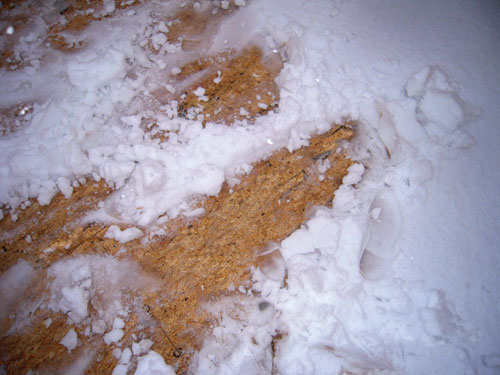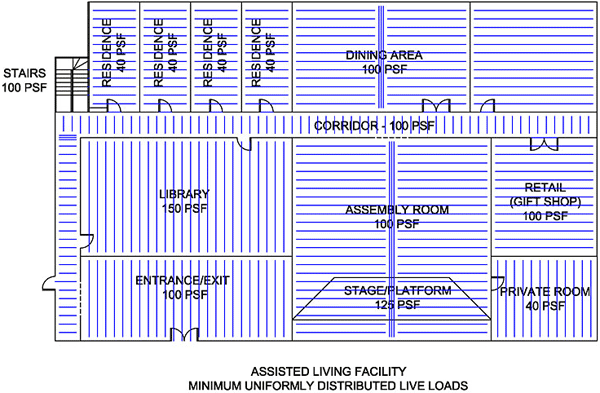The Makings of a Great Subfloor
The floor deck should be dry prior to installation of finish floor coverings. In removing standing water, there are two main options.
• Sweeping and wet vacuuming are the preferred options for removing standing water on floor decks. Sweeping may be difficult if wall framing has been installed.
• Drilling well-spaced weep holes no greater than 1/2 inch is a common approach but is the least effective method for removing standing water. If the floor deck is relatively flat, the weep hole will only drain water in the immediate vicinity of the hole.
Snow and Ice Accumulation. During winter months, accumulation of snow and ice will not normally affect the structural integrity of high performance panels. Once the ice and snow have melted and the building closed in, it is important to ensure the panels have completely dried prior to finish floor installation. Ice and snow can safely be removed from high performance panels with dark, coarse sand, which will absorb heat from the sun, assist the melting process and can help minimize the possibility of slipping.
 |
High moisture resistance helps high performance panels perform in the harshest weather. |
Glues—A Sustainability Issue
Some subflooring panels are manufactured in accordance with the product standard, PS 2, Performance Standard for Wood-Based Structural-Use Panels. The adhesives used to produce these panels are a combination of exterior type phenol formaldehyde (PF) and isocyanate resins. During manufacturing, PF resins are exposed to heat and pressure. This heat and pressure cures the resin into nonreactive and stable material. Isocyanate resins contain no formaldehyde.
Safety questions or concerns associated with formaldehyde are typically associated with products manufactured using urea formaldehyde such as particleboard, hardwood plywood, and medium-density fiberboard (MDF) moldings. According to the U.S. Department of Housing and Urban Development (HUD), the emission levels for structural wood panels manufactured using phenol formaldehyde are too low to be considered significant. Because of the low emission levels, U.S. HUD has exempted phenolic-bonded wood structural panels from required testing and certification.
The California Air Resources Board (CARB) Air Toxic Control Measure for Wood Products that went into effect on January 1, 2009, is arguably the most restrictive regulation in the United States governing formaldehyde emissions. Sections 93120(b) and 93120.1(a)(8) define the products covered by this regulation as hardwood plywood, particle board, and MDF. OSB products, including high performance panels, are exempt from this regulation.
Installation: Straightforward Measures Lead to Superior Performance
Panels that are not installed properly sacrifice the integrity of the structure. Because nails and screws frequently miss the joints, panels with a printed fastener guide are preferable. High performance panels are available with a pre-marked nailing grid that specifies the location of the joists, eliminating the need to snap lines, which can be difficult in the rain as well as for newer workers in the construction crew. “The grid system means no more chalk lines and no more excuses for missing rows of nails,” says Mike Hancock of Edmond, Oklahoma's Hancock Building & Design.
Another installation benefit of high performance panels is the reduction of the “weak axis” issue. Joists are typically laid out in the same direction within a structure, with subflooring installed perpendicular to the joists to increase the stability of the floor, with the strong axis corresponding to the long side of the 8-foot sheet of subflooring, and the weak axis to the shorter or 4-foot edge. Panels that are inadvertently installed parallel to the structure, along the “weak axis,” can compromise the strength of the flooring system. Instead, panels with above-code strength properties, such as high performance panels, should be selected to avoid this situation. The following figure shows an example of a hypothetical office building with different loads, and how PS 2 parallel strength levels would not meet the requirements in multiple areas.
 |









